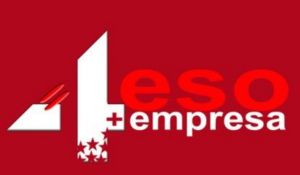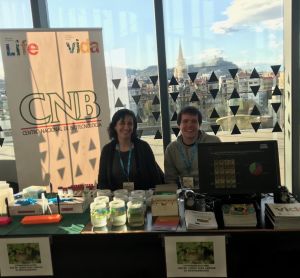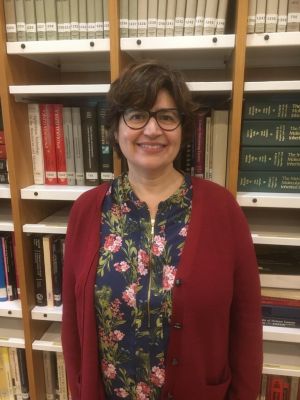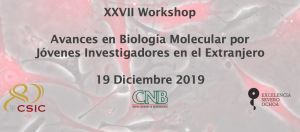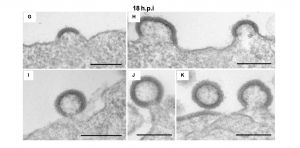Nucleic Acids Res. 2020 Jan 13. pii: gkz1200.
Carrasco C, Pastrana CL, Aicart-Ramos C, Leuba SH, Khan SA, Moreno-Herrero F.
Abstract
The rolling-circle replication is the most common mechanism for the replication of small plasmids carrying antibiotic resistance genes in Gram-positive bacteria. It is initiated by the binding and nicking of double-stranded origin of replication by a replication initiator protein (Rep). Duplex unwinding is then performed by the PcrA helicase, whose processivity is critically promoted by its interaction with Rep. How Rep and PcrA proteins interact to nick and unwind the duplex is not fully understood. Here, we have used magnetic tweezers to monitor PcrA helicase unwinding and its relationship with the nicking activity of Staphylococcus aureus plasmid pT181 initiator RepC. Our results indicate that PcrA is a highly processive helicase prone to stochastic pausing, resulting in average translocation rates of 30 bp s-1, while a typical velocity of 50 bp s-1 is found in the absence of pausing. Single-strand DNA binding protein did not affect PcrA translocation velocity but slightly increased its processivity. Analysis of the degree of DNA supercoiling required for RepC nicking, and the time between RepC nicking and DNA unwinding, suggests that RepC and PcrA form a protein complex on the DNA binding site before nicking. A comprehensive model that rationalizes these findings is presented.
doi: 10.1093/nar/gkz1200.
El CNB participa en el programa 4ºESO y Empresa de la Comunidad de Madrid
Los destinatarios son todos los alumnos que cursen 4º de Enseñanza Secundaria. Consiste en la estancia voluntaria en empresas durante 3, 4 o 5 días lectivos consecutivos con el finde enriquecer el currículo de los alumnos y aproximarles al mundo laboral del que ellos formarán parte en el futuro.
OFERTA CURSO ACADÉMICO 2023-2024
SOLICITUDES: ENTRE el 11 Y EL 19 DE ENERO 2024 (INCLUIDOS)
ESTANCIA EN EL CNB: del 2 al 5 de abril
Para participar
Se aceptan un máximo de 3 estudiantes por centro educativo. La persona responsable del programa en el centro educativo deberá rellenar el formulario WEB en el plazo indicado anteriormente. Los seleccionados/as serán contactados por email a partir de 24 de enero de 2024 para continuar con el proceso administrativo de adjudicación de plazas.
Plazas ofertadas: 17
Experimentales: En laboratorios de investigación del CNB
Departamento de Inmunología y Oncología: 8
Título: Células madre e inmunidad, Nº de plazas: 3, Tutoras: Mª Angeles García López, Cristina Pacios
Título: Receptores de quimioquinas como estrategia terapeutica. Nº de plazas: 1; Tutor: Jose Miguel Rodriguez Frade
Título: Dianas moleculares para cáncer e inflamación. Nº de plazas: 2, Tutoras: Rosa María Liébana Gallego, Sara Casado Ramos
Título: Dinámica de linfocitos B. Nº de plazas: 1; Tutora: Yolanda R. Carrasco
Título: Inmunidad frente a virus y cáncer. Nº de plazas: 1; Tutora: Andrea Sánchez de la Cruz
Departamento de Genética Molecular de Plantas: 1
Título: Control genético de la formación de ramas en plantas. Nº de plazas: 1; Tutora: Gema Castillo García
Departamento Biología Molecular y Celular: 4
Título: Poxvirus y Vacunas. Nº de plazas: 2; Tutor: Juan García Arriaza
Título: Modelos animales por manipulación genética Nº de plazas: 1; Tutor: Lluis Montoliu José
Título: Inmunoterapia frente al cáncer. Nº de plazas: 1; Tutor: Esteban Veiga
Departamento de Biología de Sistemas y Biología Sintética: 2
Título: Microbiología molecular ambiental; Nº de plazas: 1; Tutor: Esteban Martínez García
Título: Biotecnología de sistemas. Fechas: 2-5 abril 2024; Tutor: Juan Nogales Enrique
Servicios de apoyo a la investigación:
Título: Servicio de Microscopía Óptica Avanzada. Nº de plazas: 1; Tutora: Ana Mª Oña Blanco
Título: Informática Científica. Nº de plazas: 1; Tutor: José Ramón Valverde Carrillo
OFERTA CURSO ACADÉMICO 2022-2023
Plazas ofertadas: 10
Fechas para la realización de las estancias: 27-30 de marzo (4 días)
Experimentales: En laboratorios de investigación del CNB
Departamento de Inmunología y Oncología: 5
Departamento de Genética Molecular de Plantas: 2
Departamento de Biología de Sistemas y Biología Sintética: 2
Servicios de apoyo a la investigación:
Servicio de Tecnología de la Información y Comunicaciones (Apoyo informático): 1
Se aceptan solicitudes desde el 7 de febrero al 14 de febrero de 2023.
Para participar
Enviar un email a la oficina de divulgación con el asunto 4 y empresa, incluyendo la documentación necesaria y un breve párrafo o diocumento con la motivación para hacer la estancia en el CNB y cual es la plaza elegida (hasta un máximo de 3).
Los seleccionados/as serán contactado por email antes del 21 de febrero de 2023.
OFERTA CURSO ACADÉMICO 2021-2022
Plazas ofertadas:
Fechas para la realización de las estancias: 19 de abril-22 de abril (4 días)
Plazas: 14
Experimentales: En laboratorios de investigación del CNB
Departamento de Inmunología y Oncología: 5
Departamento de Genética Molecular de Plantas: 2
Departamento de Biotecnología Microbiana: 2
Departamento de Biología Molecular y Celular: 1
Departamento de Biología de sistemas y Biología Sintética: 1
Servicios de apoyo a la investigación:
Servicio de Computación Científica (por ejemplo desarrollo de programas para la predicción de estructuras de proteínas): 1
Servicio de Instrumentación Científica: (calibrado, validación, mantenimiento y reparación de instrumental científico): 2
Oficina de comunicación y divulgación científica: (mecanismos de difusión de la investigación del centro): 1
Se aceptan solicitudes hasta el 11 de febrero.
Para participar
Enviar un email a la oficina de divulgación con el asunto 4 y empresa, incluyendo la motivación para hacer la estancia en el CNB y cual es la plaza elegida (hasta un máximo de 3).
Los seleccionados/as serán contactado por email antes del 18 de febrero de 2022.
CANCELADO EL PROGRAMA DURANTE EL CURSO 2019-2020
debido a las medidas excepcionales puestas en marcha para contener la propagación del SARS-CoV2 se cancela la realización del progrma en el curso académico 2019-2020.
Curso académico 2019-2020
Plazas ofertadas: 13
Fechas para la realización de las estancias: 30 de marzo al 2 de abril (4 días)
Plazas:
Departamento Inmunología y Oncología: 6
Departamento de Genética Molecular de Plantas: 3
Departamento de Biotecnología Microbiana: 1
Departamento de Estructura de Macromoléculas: 1
Servicio de Computación Científica: 1
Oficina de divulgación: 1
Se aceptan solicitudes hasta el 14 de febrero.
Para participar
Enviar un email a la oficina de divulgación con el asunto 4 y empresa, incluyendo la motivación para hacer la estancia en el CNB y cual es la plaza elegida (hasta un máximo de 3).
Los seleccionados/as serán contactado por email antes del 21 de febrero
Curso académico 2018-2019
6 estudiantes de secundaria participaron en el programa durante este curso académico
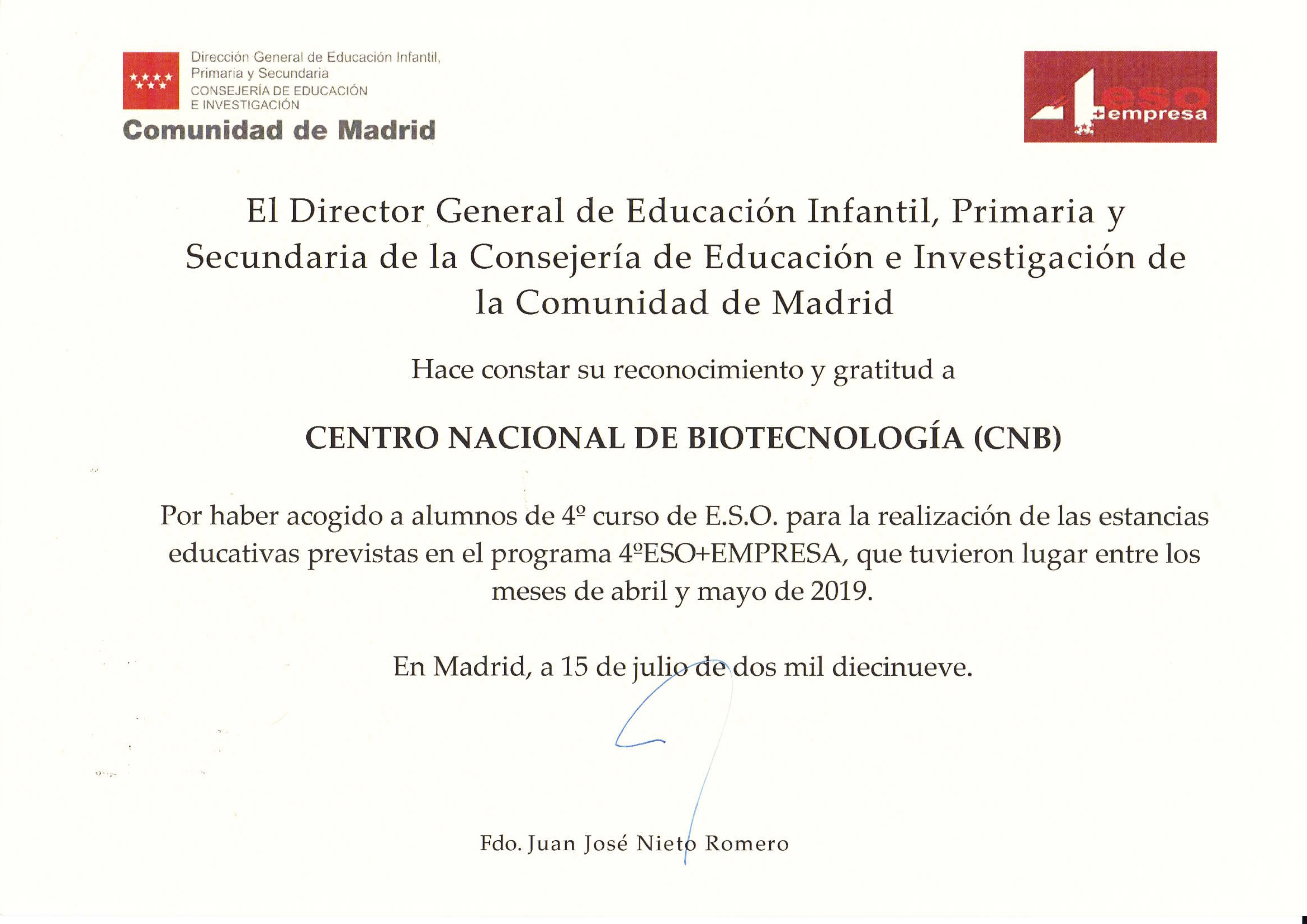
El CNB está presente en la nueva edición de 100xCiencia! Este año 100xCiencia.4 pone el acento en la importancia de la I+D+i, y cómo ello genera un retorno tangible para la ciudadanía a la vez que se traduce en la generación de productos y servicios que mejoran el bienestar y la calidad de vida del público. Al mismo tiempo, en el evento las instituciones de SOMMa tendrán ocasión de mostrar sus proyectos a la ciudadanía. Bajo el título “¿Qué hace la ciencia para ti?”, esta edición mostrará casos concretos de éxito en la traslación de investigación en productos, servicios, o ideas de empresa que se materializaron en spin-offs que han terminado teniendo un impacto en la vida del común de la ciudadanía. Las iniciativas expuestas mostrarán este impacto de la I+D+I en la sociedad.
Después de las pasadas ediciones en Canarias, Alicante y Madrid, este año el evento tendrá lugar en Donostia/San Sebastián. En esta ocasión, la organización corre a cargo del Basque Centre on Cognition, Brain and Language (BCBL), junto con SOMMa.
Nat Commun. 2020 Jan 2;11(1):55.
Vilas JL, Tagare HD, Vargas J, Carazo JM, Sorzano COS.
Abstract
The introduction of local resolution has enormously helped the understanding of cryo-EM maps. Still, for any given pixel it is a global, aggregated value, that makes impossible the individual analysis of the contribution of the different projection directions. We introduce MonoDir, a fully automatic, parameter-free method that, starting only from the final cryo-EM map, decomposes local resolution into the different projection directions, providing a detailed level of analysis of the final map. Many applications of directional local resolution are possible, and we concentrate here on map quality and validation.
doi: 10.1038/s41467-019-13742-w.
Muchas macromoléculas biológicas utilizan sistemas de control alostérico para ensamblarse, desensamblarse o cambiar de conformación. Así, cambios en una región de la molécula afectan al comportamiento y la función de la misma en otras regiones. Por ejemplo, la unión de un ligando produce un cambio conformacional que activa o inactiva una enzima.
El desarrollo de moléculas sintéticas que tengan este tipo de propiedades resulta muy complejo y hasta ahora los esfuerzos invertidos en este área solo han conseguido unos pocos resultados exitosos. De hecho, en el caso concreto de la creación de nuevos ensamblajes protéicos de diseño, los resultados hasta ahora se han basado en un sistema tipo puzzle, donde la superficie de cada una de las piezas rígidas que se van a ensamblar es modificada para producir una interacción estable. Ahora, investigadores del Centro Nacional de Biotecnología, en colaboración con el IMDEA Nanociencia, el Centro de Investigaciones Biológicas y las Universidades de Granada y California han desarrollado un modelo que permite controlar de forma alostérica la formación y ensamblaje de proteínas mediante la inclusión de interruptores moleculares formados gracias a cambios en la estructura tridimensional de la proteína.
Contact: Carlos Oscar S. Sorzano
Staff: Ana Cayuela López
The goal of this unit is to facilitate the extraction of the largest amount possible of information from the acquired images. In particular:
- We support researchers in the use of specific image processing software.
- We develop specific software to solve common image analysis problems in microscopy (particle analysis and tracking; diffusion processes; localization, co-localization and spatial statistics; quantification of relative fluorescence; shape, textural and morphology quantification; event detection and counting; distortion corrections; characterization of image quality; etc.)
- We develop software that allows the automation of the steps above for the most common workflows. Real-time processing is targeted.
- We help in the definition of the acquisition parameters so that the posterior image analysis is most profitable.
- We organize courses on image analysis for microscopy.
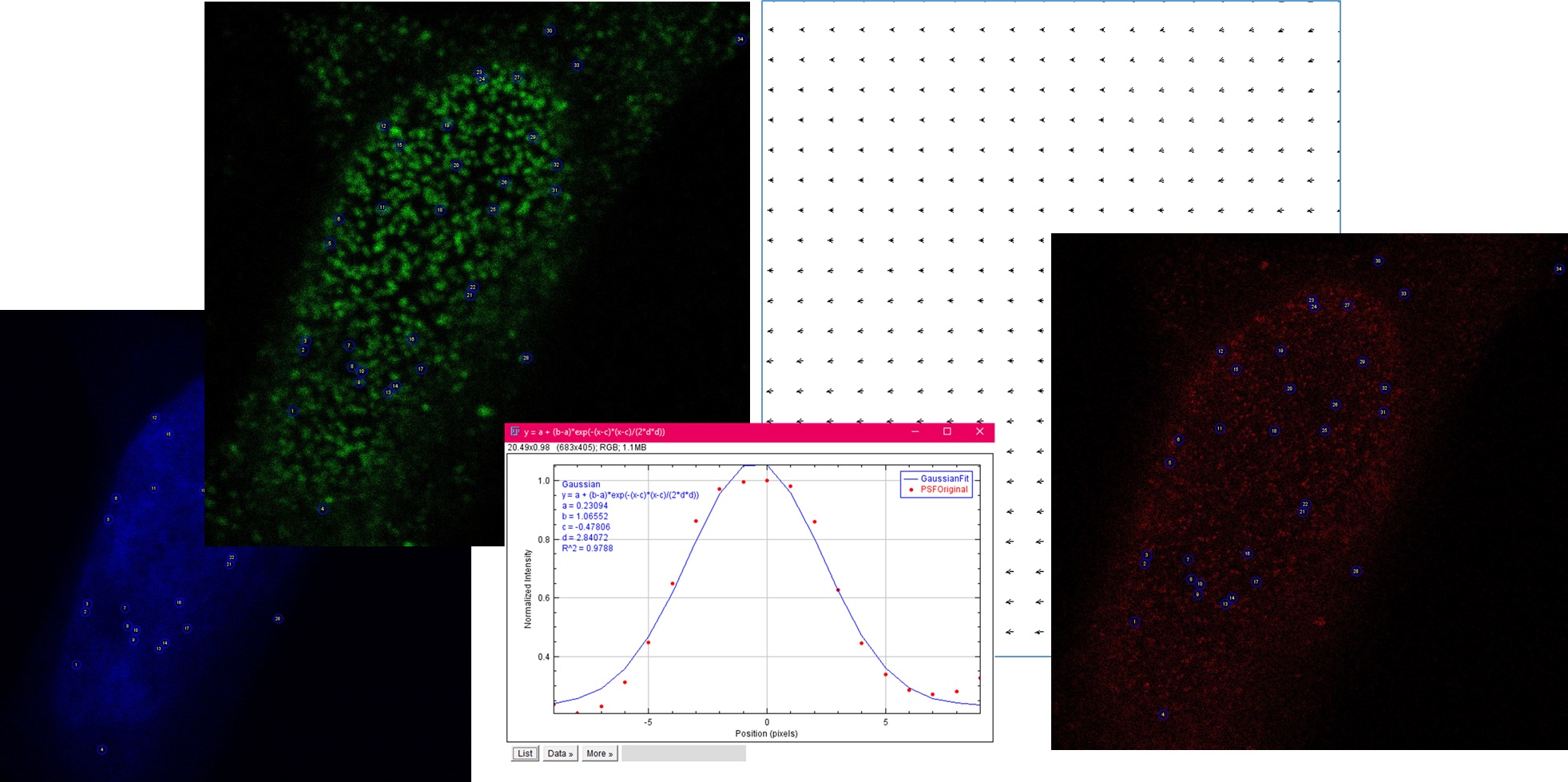
Contact: Javier Conesa
The correlative microscopy platform will provide expertise to integrate the different microscopy technologies available at the CNB, including Optical Microscopy and Cryoelectron Microscopy to answer complex biological questions in cryopreserved samples. The range of samples covered ranges from animal and plant tissues, bacterial and cell cultures, cell fractions, viruses and protein complexes.
Correlative pipelines will include those relating cryo fluorescence imaging and cryo electron microscopy. This will include the following steps combined according to the project needs: sample vitrification by plunge freezing and high pressure freezing, cryo widefield and confocal visible light microscopy, cryo focused-ion-beam lamella generation, cryo focused-ion-beam slice and view, transmission electron tomography data acquisition and advise for accessing to synchrotron beamtime.
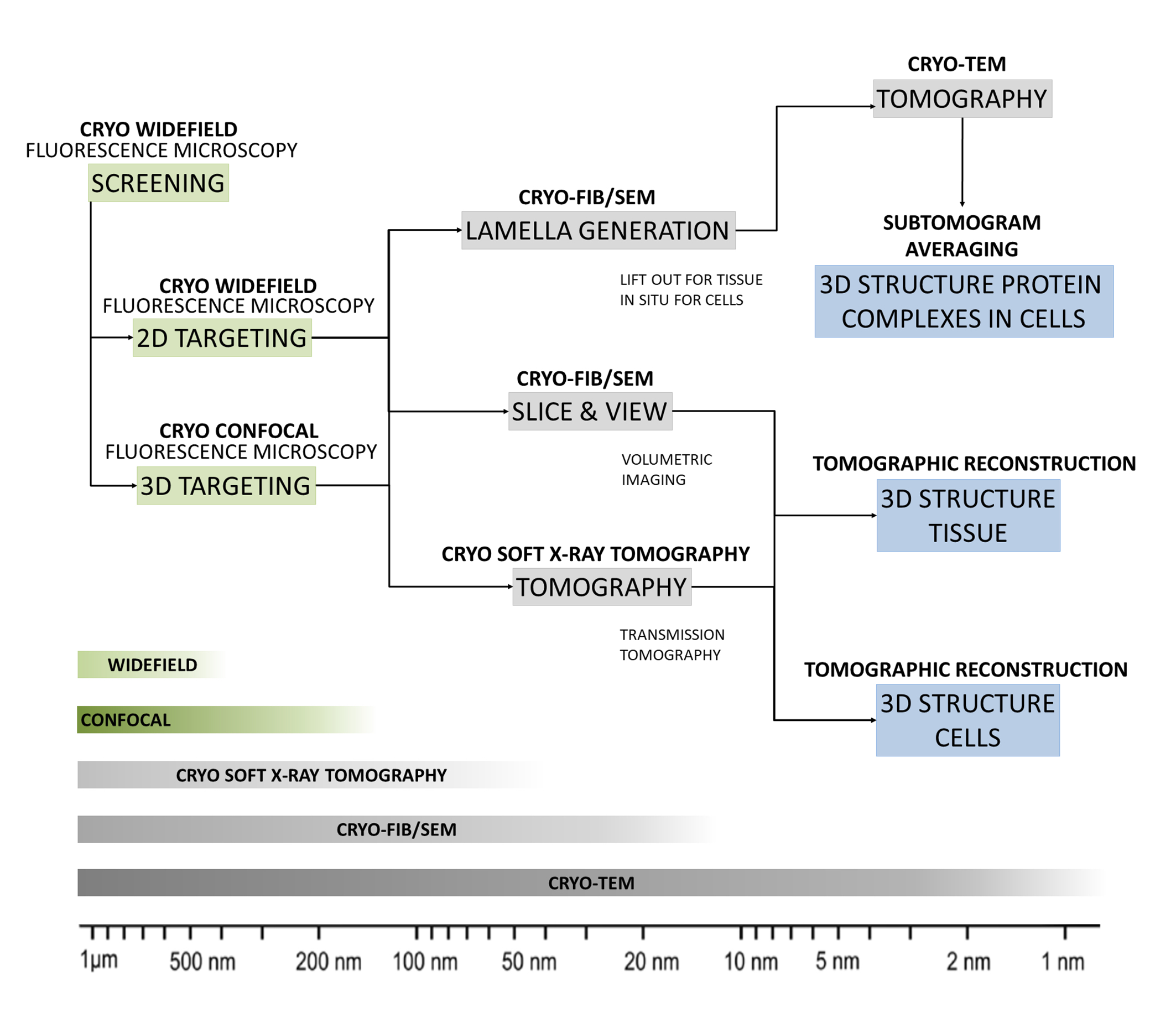
El proyecto “Severo Ochoa y el código genético: descifrando mensajes encriptados” ha sido uno de los 28 proyectos seleccionados por la Fundación General del CSIC (FGCSIC) en la tercera edición del Programa Cuenta la Ciencia
El proyecto, basado en los experimentos que llevaron al descubrimiento del código genético, busca acercar la ciencia a los jóvenes a través de la “resolución de un misterio” poniendo como ejemplo el trabajo del profesor Severo Ochoa, en el 60 aniversario de la concesión del premio Nobel. La actividad, destinada a estudiantes de 4 de ESO se realizará en Institutos de Enseñanza Secundaria (IES) de varias localidades de ámbito rural, y en barrios menos favorecidos de ciudades grandes para favorecer el acceso de jóvenes de este entorno a la ciencia.
Rosario Fernández, organizadora de la actividad recalca cómo “los experimentos que llevaron al desciframiento del código genético son un claro ejemplo de lo apasionante que puede ser la ciencia. La idea es dar a conocer estos experimentos a los alumnos y a la vez lanzar el mensaje de que la ciencia es divertida, interesante y que está al alcance de todos”.
El material producido con la financiación del Programa Cuenta la Ciencia quedará a disposición del equipo de Recursos Educativos del CSIC y de los distintos IES en los que se realice la actividad.
30/4/2020. Ya está disponible el vídeo divulgativo: Severo Ochoa y el código genético: descifrando mensajes encriptados"
Next 19th of December 2019, the Centro Nacional de Biotecnología (CNB-CSIC) will hold the XXVI edition of the traditional workshop Advances in Molecular Biology by Young Researchers Abroad.
During the day, we will host short talks by young scientist working abroad and the round table: Funding opportunities for young researchers in Spain.
Attendance is free and open to everybody, but registration is mandatory through this form.
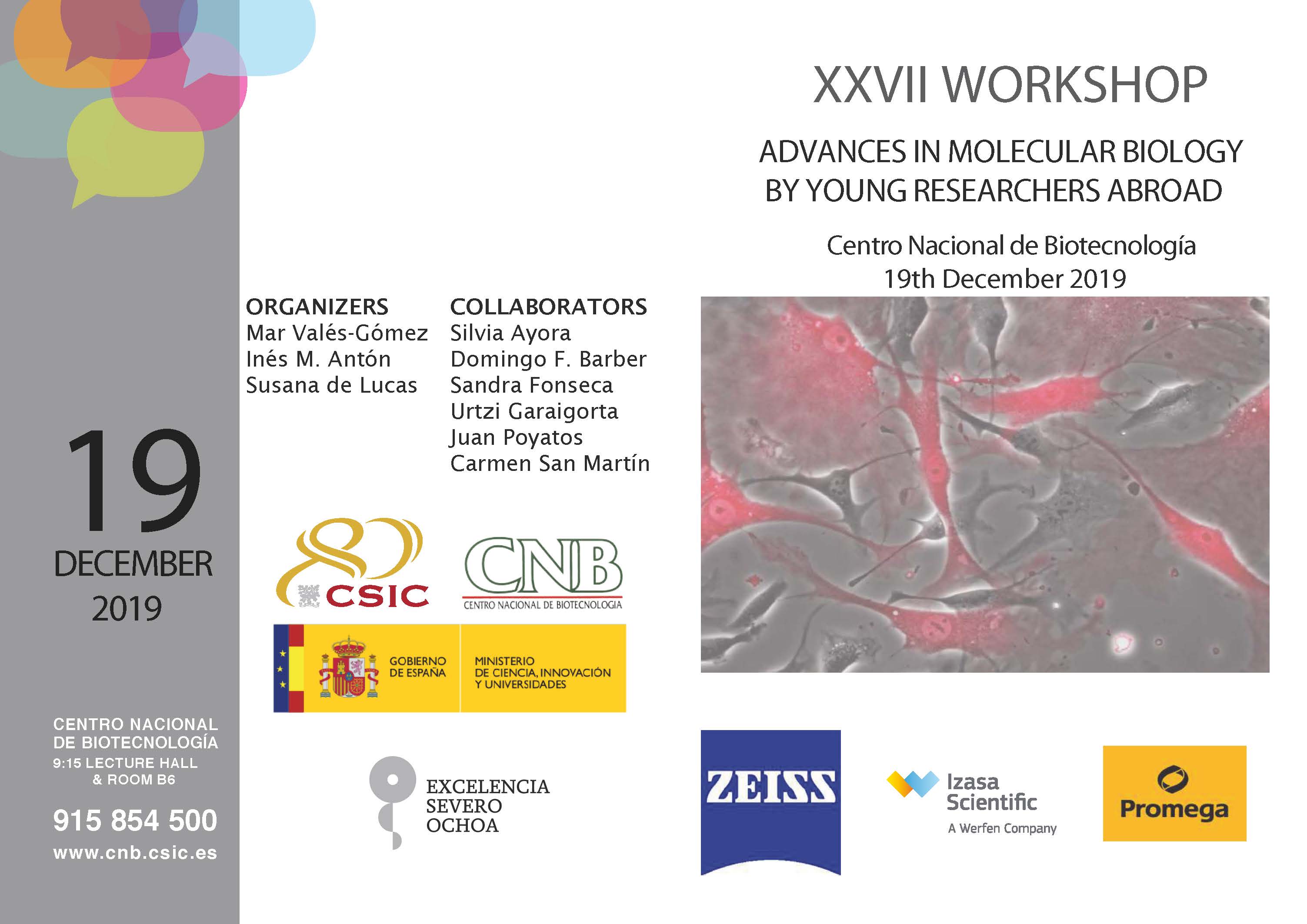
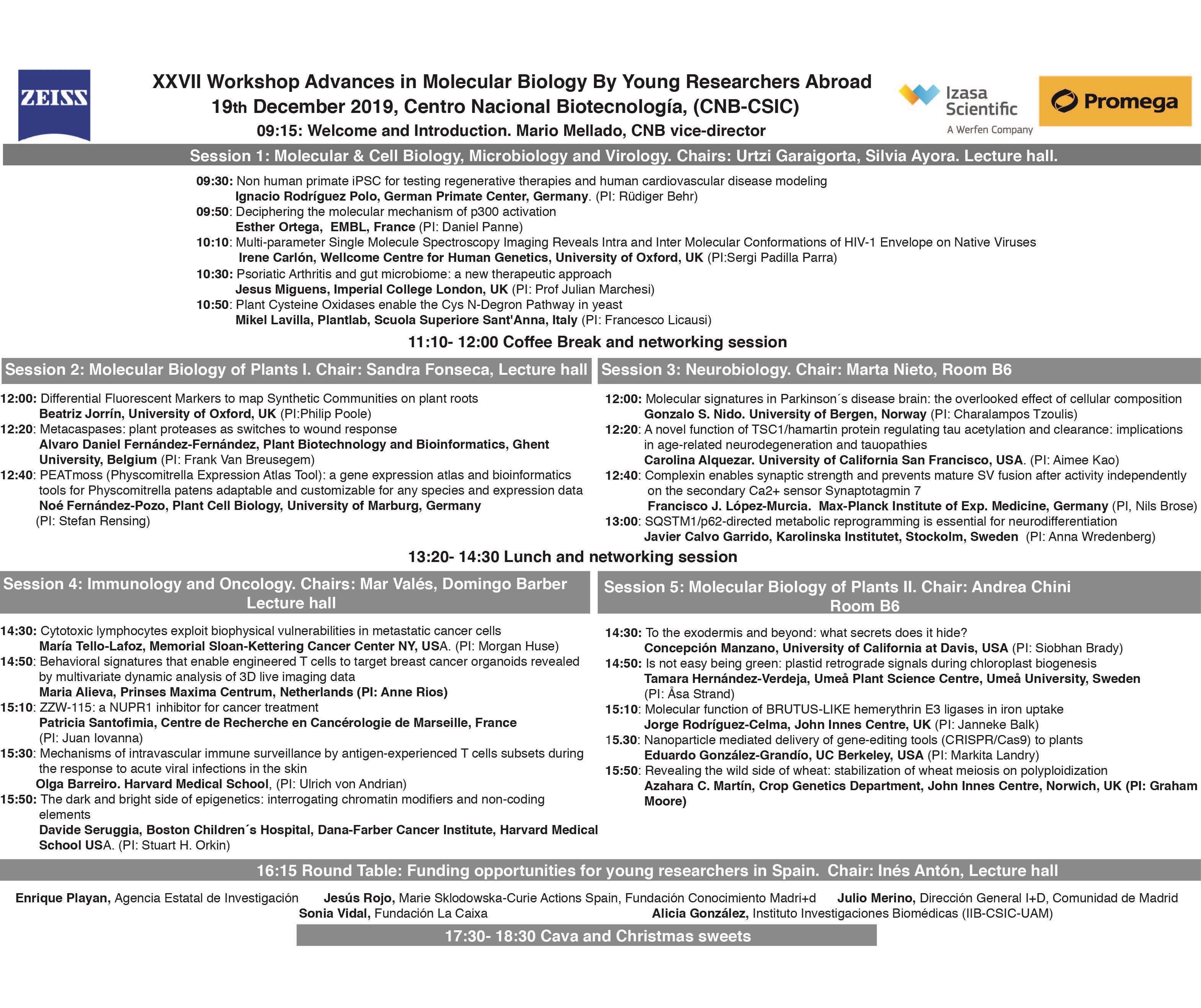
- Científicos del CNB colaboran en el desarrollo de una vacuna preventiva que combina tres inmunógenos para potenciar la inmunidad frente al virus
Investigadores del Consejo Superior de Investigaciones Científicas (CSIC) están colaborando en el desarrollo internacional de una vacuna contra el virus de la inmunodeficiencia humana (VIH), causante del SIDA, a partir de la combinación de tres inmunógenos. Este nuevo prototipo de futura vacuna ya ha pasado la fase del ensayo clínico 1b. Los resultados se han publicado en la revista Lancet HIV.
La participación del CSIC en el desarrollo de la nueva vacuna está liderada por el grupo del investigador Mariano Esteban, del Centro Nacional de Biotecnología (CNB). El grupo de Esteban es el responsable de uno de los tres inmunógeno utilizados, el vector NYVAC. “Esta combinación acelera la activación de la respuesta inmune específica, lo que es importante para conseguir protección. Estos procesos de inmunización son muy relevantes para futuros ensayos de eficacia contra el VIH”, explica Esteban.
COOKIES POLICY
A cookie is a text file that is stored on your computer or mobile device via a web server and only that server will be able to retrieve or read the contents of the cookie and allow the Web site remember browser preferences and navigate efficiently. Cookies make the interaction between the user and the website faster and easier.
General information
This Website uses cookies. Cookies are small text files generated by the web pages you visit, which contain the session data that can be useful later in the website. In this way this Web remembers information about your visit, which can facilitate your next visit and make the website more useful.
How do cookies?
Cookies can only store text, usually always anonymous and encrypted. No personal information is ever stored in a cookie, or can be associated with identified or identifiable person.
The data allow this website to keep your information between the pages, and also to discuss how to interact with the website. Cookies are safe because they can only store information that is put there by the browser, which is information the user entered in the browser or included in the page request. You can not run the code and can not be used to access your computer. If a website encrypts cookie data, only the website can read the information.
What types of cookies used?
The cookies used by this website can be distinguished by the following criteria:
1. Types of cookies as the entity that manages:
Depending on who the entity operating the computer or domain where cookies are sent and treat the data obtained, we can distinguish:
- Own cookies: are those that are sent to the user's terminal equipment from a computer or domain managed by the editor itself and from which provides the service requested by the user.
- Third party cookies: these are those that are sent to the user's terminal equipment from a machine or domain that is not managed by the publisher, but by another entity data is obtained through cookies.
In the event that the cookies are installed from a computer or domain managed by the editor itself but the information collected by these is managed by a third party can not be considered as party cookies.
2. Types of cookies as the length of time that remain active:
Depending on the length of time that remain active in the terminal equipment can be distinguished:
- Session cookies: cookies are a type designed to collect and store data while the user accesses a web page. Are usually used to store information that only worth preserving for the service requested by the user at any one time (eg a list of products purchased).
- Persistent cookies: cookies are a type of data which are stored in the terminal and can be accessed and treated for a period defined by the head of the cookie, and can range from a few minutes to several years.
3. Cookies types according to their purpose:
Depending on the purpose for which the data are processed through cookies, we can distinguish between:
- Technical cookies: these are those that allow the user to navigate through a web page or application platform and the use of different options or services it exist as, for example, control traffic and data communication, identify the session, access to restricted access parts, remember the elements of an order, make the buying process an order, make an application for registration or participation in an event, use security features while browsing store content for dissemination videos or sound or share content via social networks.
- Customization cookies: these are those that allow the user to access the service with some general characteristics based on a predefined set of criteria in the user terminal would eg language, the type of browser through which you access the service, the locale from which you access the service, etc.
- Analysis cookies: they are those that allow the responsible for them, monitoring and analyzing the behavior of users of the web sites that are linked. The information gathered through such cookies are used in measuring the activity of web sites, application or platform and for the profiling of user navigation of such sites, applications and platforms, in order to make improvements function data analysis how users use the service.
Management tool cookies
This Website uses Google Analytics.
Google Analytics is a free tool from Google that primarily allows website owners know how users interact with your website. Also, enable cookies in the domain of the site in which you are and uses a set of cookies called "__utma" and "__utmz" to collect information anonymously and reporting of website trends without identifying individual users..
For statistics of use of this website use cookies in order to know the level of recurrence of our visitors and more interesting content. This way we can concentrate our efforts on improving the most visited areas and make the user more easily find what they are looking for. On this site you can use the information from your visit for statistical evaluations and calculations anonymous data and to ensure the continuity of service or to make improvements to their websites. For more details, see the link below privacy policy [http://www.google.com/intl/en/policies/privacy/]
How to manage cookies on your computer: disabling and deleting cookies
All Internet browsers allow you to limit the behavior of a cookie or disable cookies within settings or browser settings. The steps for doing so are different for each browser, you can find instructions in the help menu of your browser.
If you decline the use of cookies, since it is possible thanks to the preferences menu of your browser or settings, reject, this website will continue to function properly without the use of the same.
Can you allow, block or delete cookies installed on your computer by setting your browser options installed on your computer:
- For more information about Internet Explorer click here.
- For more information on Chrome click here.
- For more information about Safari click here.
- For more information about Firefox click here.
Through your browser, you can also view the cookies that are on your computer, and delete them as you see fit. Cookies are text files, you can open and read the contents. The data within them is almost always encrypted with a numeric key corresponding to an Internet session so often has no meaning beyond the website who wrote it.
Informed consent
The use of this website on the other hand, implies that you paid your specific consent to the use of cookies, on the terms and conditions provided in this Cookies Policy, without prejudice to the measures of deactivation and removal of cookies that you can take, and mentioned in the previous section.

